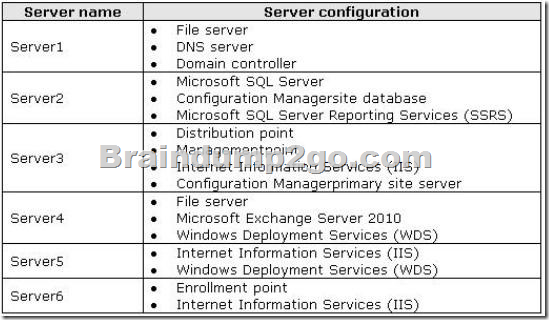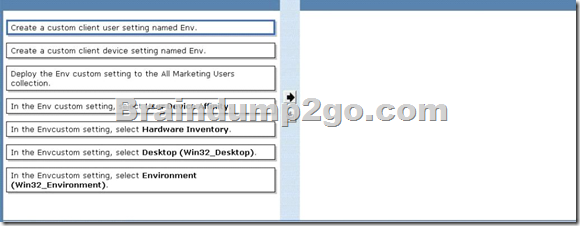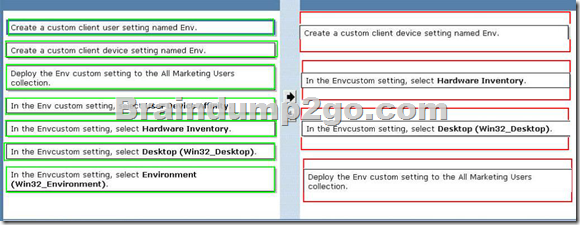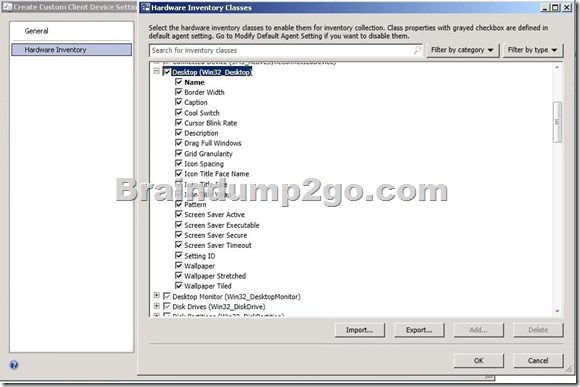16 03 2015
[LATEST UPDATED DUMPS] Latest 70-243 Brain Dumps Questions PDF & VCE Free Share (51-60)
All Latest Updated Questions and Answers in Braindump2go 70-243 Exam Dumps will not take you a lot of time to comprehend and you can easily cover up the entire Microsoft 70-243 syllabus for your examination.Download Braindump2go Free 70-243 Sample Questions Now, Pass 70-243 Exam in advance!
Vendor: Microsoft
Exam Code: 70-243
Exam Name: Administering and Deploying System Center 2012 Configuration Manager
QUESTION 51
Your network contains a System Center 2012 Configuration Manger environment.
You need to create a collection that contains all of the virtual machines.
Which query should you use?
A. select * from SMS_R_System
where SMS_R_System.ResourceID not in
(select ResourceID from SMS_R_System
where SMS_R_System.IsVirtualMachine != 1)
B. select * from SMS_R_System
where SMS_R_System.IsVirtualMachine != 1
C. select * from SMS_R_System
where SMS_R_System.IsVirtualMachine = 1
D. select * from SMS_R_System
where SMS_R_System.ResourceID not in
(select ResourceID from|SMS_R_System
where SMS_R_System.IsVirtualMachine = 1)
Answer: C
Explanation:
SELECT all FROM Systems Table
WHERE System property IsVirtualMachine = TRUE
QUESTION 52
Your network contains a System Center 2012 Configuration Manager environment. The environment contains a primary site server named Server1 and a server named Server2 that runs Microsoft SQL Server 2008 R2.
Server2 contains the Configuration Manager database. Server2 fails.
You install SQL Server 2008 R2 on a new server.
You name the server Server2.
You need to restore the Configuration Manager database to the new server.
What should you do?
A. From Server1, run the Site Repair Wizard.
B. From Server1, run the Configuration Manager 2012 Setup Wizard.
C. From Server2, run Microsoft SQL Server Management Studio, and then attach the backed up SQL
Server database and log files.
D. From Server2, run Microsoft SQL Server Management Studio, and then restore the backed up SQL
Server database and log files.
Answer: B
Explanation:
http://technet.microsoft.com/en-us/library/gg712697.aspx
Backup and Recovery in Configuration Manager
Recover a Configuration Manager Site
A Configuration Manager site recovery is required whenever a Configuration Manager site fails or data loss occurs in the site database. Repairing and resynchronizing data are the core tasks of a site recovery and are required to prevent interruption of operations. Site recovery is started by running the Configuration Manager Setup Wizard from installation media or by configuring the unattended installation script and then using the Setup command /script option. Your recovery options vary depending on whether you have a backup of the Configuration Manager site database.
Site Database Recovery Options
When you run Setup, you have the following recovery options for the site database:
* Recover the site database using a backup set: Use this option when you have a backup
of the Configuration Manager site database that was created as part of the Backup Site Server maintenance task run on the site before the site database failure. When you have a hierarchy, the changes that were made to the site database after the last site database backup are retrieved from the central administration site for a primary site, or from a reference primary site for a central administration site. When you recover the site database for a stand-alone primary site, you lose site changes after the last backup.
When you recover the site database for a site in a hierarchy, the recovery behavior is different for a central administration site and primary site, and when the last backup is inside or outside of the SQL Server change tracking retention period.
Further information:
SCCM 2007 needed you to run Site Repair Wizard.
QUESTION 53
Your network contains a System Center 2012 Configuration Manger environment.
You need to create a report that list all of the client computers that have an application named App1 installed.
Which query should you use to create the report?
A. SELECT SYS.Netbios_Name0, ARP.DisplayName0
FROM v_R_Sytem AS SYS INNER JOIN
v_GS_ADD_REMOVE_PROGRAMS AS ARP ON SYS.ResourceID = ARP.
ResourceID WHERE ARP.DisplayName0 NOT LIKE ‘App1’
B. SELECT SYS.Netbios_Name0 from v_R_System SYS
WHERE SYS.ResourceID NOT IN
(SELECT SYS.ResouceID
FROM v_R_System AS SYS INNER JOIN
v_GS_ADD_REMOVE_PROGRAMS AS ARP ON SYS.ResourceID = ARP.
ResourceID WHERE ARP.DisplayName0 = ‘App1’)
C. SELECT SYS.Netbios_Name0, ARP.DisplayName0
FROM v_R_Sytem AS SYS INNER JOIN
v_GS_ADD_REMOVE_PROGRAMS AS ARP ON SYS.ResourceID = ARP.
ResourceID WHERE ARP.DisplayName0 NOT IN (‘App1’)
D. SELECT SYS.Netbios_Name0 from v_R_System SYS
WHERE SYS.ResourceID IN
(SELECT SYS.ResouceID
FROM v_R_System AS SYS INNER JOIN
v_GS_ADD_REMOVE_PROGRAMS AS ARP ON SYS.ResourceID = ARP.
ResourceID WHERE ARP.DisplayName0 = ‘App1’)
Answer: D
Explanation:
SELECT computer name FROM table v_R_System (SQL Syntax)
WHERE resource ResourceID is IN
Add Remove Programs WHERE DisplayName0 = ‘App1’
http://www.w3schools.com/sql/sql_join_inner.asp
SQL INNER JOIN Keyword
The INNER JOIN keyword returns rows when there is at least one match in both tables.
QUESTION 54
Your network contains a System Center 2012 Configuration Manager environment.
You create a report that lists compliance information.
You schedule the report to run every day at 20:00.
You need to ensure that on Friday, you can review the results of the report created on the previous Monday.
What should you configure the report to do?
A. Use snapshots.
B. Use caching.
C. Render on Friday.
D. Use a shared schedule.
Answer: A
Explanation:
http://technet.microsoft.com/en-us/library/ms156325.aspx
Creating, Modifying, and Deleting Snapshots in Report History
Report history is a collection of report snapshots.
You can maintain report history by adding and deleting snapshots, or by modifying properties that affect report history storage.
You can create report history manually or on a schedule.
Further information:
http://technet.microsoft.com/en-us/library/ms157447.aspx
Cache a Report (Report Manager)
One way to improve performance is to configure caching properties for a report. When a report is cached, a copy of the rendered report is saved for a short period of time. The first user who requests the report must wait for all processing to complete before viewing the report. Subsequent users who request the report within the caching period can view it right away because processing has already occurred.
QUESTION 55
Your company uses System Center 2012 Configuration Manager to distribute operating system images.
You receive 300 new client computers. All of the client computers have the same hardware configuration. When you attempt to deploy a Windows 7 image to one of the client computers, you receive an error message indicating that a storage device cannot be found during the pre-boot deployment phase.
You need to ensure that you can deploy Windows 7 to the new client computers by using an image.
What should you do?
A. Import the storage drivers to the Drivers container and update the task sequence.
B. Create a new driver package and update the task sequence.
C. Update the existing boot image to include the storage drivers.
D. Clear the contents of the Drivers container and update the task sequence.
Answer: C
Explanation:
http://technet.microsoft.com/en-us/library/gg712674.aspx
Planning a Device Driver Strategy in Configuration Manager
…
Planning a Device Driver Strategy in Configuration Manager
You can add Windows device drivers that have been imported into the driver catalog to boot images. Use the following guidelines when you add device drivers to a boot image:
* Add only mass storage and network adapter device drivers to boot images because other types of drivers are not generally required. Drivers that are not required increase the size of the boot image unnecessarily.
* Add only device drivers for Windows 7 to a boot image because the required version of Windows PE is based on Windows 7.
* Ensure that you use the correct device driver for the architecture of the boot image. Do not add an x86 device driver to an x64 boot image.
QUESTION 56
Note: This question is part of a series of questions that use the same set of answer choices.
An answer choice may be correct for more than one question in the series.
Your network contains a System Center 2012 Configuration Manager environment as shown in the exhibit. (Click the Exhibit button.)
The network contains six servers. The servers are configured as shown in the following table.
You need to ensure that mobile device information is available in the hardware inventory.
What should you do?
A. Install a management point on Server5.
B. Configure IIS to support only HTTPS on Server5.
C. Install a management point on Server2.
D. Install Network Load Balancing (NLB) on Server3.
E. Install an enrollment proxy point on Server6.
F. Configure IIS to support only HTTP on Server3.
G. Configure the Exchange connector on Server3.
H. Install Network Load Balancing (NLB) on Server6.
I. Install a PXE-enabled protected distribution point on Server5.
J. Install the Windows Cluster service on Server3.
K. Install a PXE-enabled protected distribution point on Server4.
L. Install the Windows Cluster service on Server6.
M. Install Windows Server Update Services (WSUS) on Server3.
N. Install a protected distribution point on Server1.
O. Install a software update point on Server3.
Answer: G
Explanation:
http://technet.microsoft.com/en-us/library/gg682022.aspx
Determine How to Manage Mobile Devices in Configuration Manager
Use the following information to help you decide how to manage mobile devices in System Center 2012 Configuration Manager.
You can use Configuration Manager to enroll mobile devices and install the Configuration Manager client, you can use the mobile device legacy client (for example, for Windows CE mobile operating systems), and you can use the Exchange Server connector. In addition, in Configuration Manager SP1, you can enroll devices that run Windows Phone 8, Windows RT, and iOS by using the Windows Intune connector.
The following table lists these four mobile device management methods and provides information about the management functions that each method supports:

http://technet.microsoft.com/en-us/library/gg681976.aspx#BKMK_Determine_EnrollmentPoints
Determine the Site System Roles for Client Deployment in Configuration Manager – Determine Whether You Require an Enrollment Point and an Enrollment Proxy Point
Configuration Manager requires the enrollment point and the enrollment proxy point to enroll mobile devices and to enroll certificates for Mac computers (Configuration Manager SP1 only). These site system roles are not required if you will manage mobile devices by using the Exchange Server connector, or if you install the mobile device legacy client (for example, for Windows CE), or if you request and install the client certificate on Mac computers independently from Configuration Manager.
QUESTION 57
Your network contains a System Center 2012 Configuration Manager environment.
You create two custom client agent settings named ClientSettings1 and ClientSettings2.
You apply ClientSettings1 to all of the client computers in the sales department.
You apply ClientSettings2 to all of the client computers in the marketing department.
The client computers in the marketing department contain several custom registry settings.
You need to collect the custom registry settings from the marketing department computers.
What should you do?
A. Edit the default client agent settings and include the custom registry information.
B. Edit ClientSettings2 and include the custom registry information.
C. Create a new set of custom client agent settings for the marketing department and include the custom
registry information.
D. Edit ClientSettings2 and exclude the custom registry information.
Answer: C
Explanation:
http://technet.microsoft.com/en-us/library/gg682109#BKMK_CustomClientSettings
– Create a new set of custom client agent settings for the marketing department and include the custom registry information.
– Edit ClientSettings2 and include the custom registry information. <— probably not
Because editing isn’t that easy.
It is common sense, that you just add another client setting and deploy it to the collection.
Why? All settings can be separately deleted and especially named. Easier to handle.
QUESTION 58
Drag and Drop Question
Your network contains a System Center 2012 Configuration Manager environment.
You create a collection named All Marketing Users.
You need to inventory the desktop settings of the All Marketing Users collection.
What should you do?
To answer, move the four appropriate actions from the list of actions to the answer area and arrange them in the correct order.
Answer:
Explanation:
http://technet.microsoft.com/en-us/library/gg712290.aspx
How to Extend Hardware Inventory in Configuration Manager
System Center 2012 Configuration Manager hardware inventory reads information about devices by using Windows Management Instrumentation (WMI). WMI is the Microsoft implementation of web-based Enterprise Management (WBEM), which is an industry standard for accessing management information in an enterprise environment.
In previous versions of Configuration Manager, you could extend hardware inventory by modifying the file sms_def.mof on the site server.
In System Center 2012 Configuration Manager, you no longer edit the sms_def.mof file as you did in Configuration Manager 2007. Instead, you can enable and disable WMI classes, and add new classes to collect by hardware inventory by using client settings. Configuration Manager provides the following methods to extend hardware inventory:
Enable or disable existing inventory classes – You can enable or disable the default inventory classes used by Configuration Manager or you can create custom client settings that allow you to collect different hardware inventory classes from specified collections of clients.
Add a new inventory class – You can add a new inventory class from the WMI namespace of another device.
Import and export hardware inventory classes – You can import and export Managed Object Format (MOF) files that contain inventory classes from the Configuration Manager console.
Create NOIDMIF Files – Use NOIDMIF files to collect information about client devices that cannot be inventoried by Configuration Manager.
Create IDMIF Files – Use IDMIF files to collect information about assets in your organization that are not associated with a Configuration Manager client, for example, projectors, photocopiers and network printers.
http://msdn.microsoft.com/en-us/library/windows/desktop/aa394121%28v=vs.85%29.aspx
Win32_Desktop class (Windows)
The Win32_Desktop WMI class represents the common characteristics of a user’s desktop. The properties of this class can be modified by the user to customize the desktop.
Further information:
The screenshots show the wizard screen.
Since we need to inventory WMI information, that means we need Hardware Inventory and you can only do that with a Custom Client Device Setting:
QUESTION 59
Your network contains a System Center 2012 Configuration Manager environment.
You create a report named Report1. Report1 is used by multiple users.
Users report that it takes too long to load Report1.
You need to reduce the amount of time it takes to load Report1.
What should you do?
A. Enable caching for the report.
B. Decrease the Size of the ReportServer database.
C. Decrease the session timeout value for the Reports website.
D. Increase the size of the ReportServerTempDB database.
Answer: A
Explanation:
Report caching can shorten the time it takes for a user to retrieve a report, particularly if the
report is large or accessed frequently. When a report is requested, a query is sent to the database, an intermediate form of the report is cached on the report server, and the final
report is rendered to the end user. Report caching forces the intermediate version of the
report to be cached on the report server and provides a more consistent user experience
with a reduced load on the database.
QUESTION 60
Your company uses System Center 2012 Configuration Manager to deploy applications.
The company purchases a new application named Appl. App1 can be installed only on client computers that run Windows 7.
You need to ensure that App1 is installed only on Windows 7 computers that have at least 2 GB of memory and 300 GB of free disk space.
What should you create?
A. a Query object
B. custom client device settings
C. requirement rules
D. custom client user settings
Answer: C
Explanation:
http://technet.microsoft.com/en-us/library/gg682082.aspx
How to Deploy Applications in Configuration Manager
Before you can deploy an application in Microsoft System Center 2012 Configuration Manager, you must create at least one deployment type for the application.
http://technet.microsoft.com/en-us/library/gg682174.aspx
How to Create Deployment Types in Configuration Manager
Steps to Create a Deployment Type
Step 1: Start the Create Deployment Type Wizard.
Step 2: Specify whether you want to automatically detect or to manually define the deployment type information.
Step 3: Specify the content options for the deployment type.
Step 4: Configure the detection methods to indicate the presence of the application.
Step 5: Specify the user experience options for the deployment type.
Step 6: Specify the requirements for the deployment type.
Requirements are used to specify the conditions that must be met before a deployment type can be installed on a client device.
Step 7: Specify the dependencies for the deployment type.
Step 8: Confirm the deployment type settings and complete the wizard.
Step 9: Configure additional options for the deployment types that contain virtual applications.
http://technet.microsoft.com/en-us/library/gg682174.aspx#BKMK_Step61
Step 6: Specify Requirements for the Deployment Type
On the Requirements page of the Create Deployment Type Wizard, click Add to open the Create Requirement dialog box, and add a new requirement.
From the Category drop-down list, select whether this requirement is for a device or a user, or select Custom to use a previously created global condition. When you select Custom, you can also click Create to create a new global condition.
Important: If you create a requirement of the category User and the condition Primary Device, and then deploy the application to a device collection, the requirement will evaluate as false.
From the Condition drop-down list, select the condition that you want to use to assess whether the user or device meets the installation requirements. The contents of this list will vary depending on the selected category.
From the Operator drop-down list, choose the operator that will be used to compare the selected condition to the specified value to assess whether the user or device meets in the installation requirement. The available operators will vary depending on the selected condition.
In the Value field, specify the values that will be used with the selected condition and operator whether the user or device meets in the installation requirement. The available values will vary depending on the selected condition and the selected operator.
Click OK to save the requirement rule and exit the Create Requirement dialog box.
On the Requirements page of the Create Deployment Type Wizard, click Next.
http://technet.microsoft.com/en-us/library/gg682048.aspx
How to Create Global Conditions in Configuration Manager
In System Center 2012 Configuration Manager, global conditions are rules that represent business or technical conditions that you can use to specify how an application is provided and deployed to client devices.
Want Pass 70-243 Exam At the first try? Come to Braindump2go! Download the Latest Microsoft 70-243 Real Exam Questions and Answers PDF & VCE from Braindump2go,100% Pass Guaranteed Or Full Money Back!
http://www.braindump2go.com/70-243.html
[100% PASS ONE TIME] Try Braindump2go Latest Microsoft 70-243 Dumps Questions And 100% Pass Exam Microsoft At The First Try (41-50) [NEW PDF] Become Microsoft 70-243 Certified With Braindump2go’s New 70-243 Test Dumps (61-70)








Comments are currently closed.